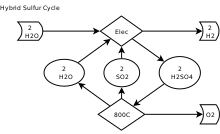Hybrid sulfur cycle

The hybrid sulfur cycle (HyS) is a two-step water-splitting process intended to be used for hydrogen production. Based on sulfur oxidation and reduction, it is classified as a hybrid thermochemical cycle because it uses an electrochemical (instead of a thermochemical) reaction for one of the two steps. The remaining thermochemical step is shared with the sulfur-iodine cycle.
The Hybrid sulphur cycle (HyS)was initially proposed and developed by Westinghouse Electric Corp. in the 1970s,[1] so it is also known as the "Westinghouse" cycle. Current development efforts in the United States are being led by the Savannah River National Laboratory.
Process description
[edit]The two reactions in the HyS cycle are as follows:[2]
- H2SO4(aq) → H2O(g) + SO2(g) + ½ O2(g) (thermochemical, T > 800 °C)
- SO2(aq) + 2 H2O(l) → H2SO4(aq) + H2(g) (electrochemical, T = 80-120 °C)
- Net reaction: H2O(l) → H2(g) + ½ O2(g)
Sulfur dioxide acts to depolarize the anode of the electrolyzer. This results in a significant decrease in the reversible cell potential (and, therefore, the electric power requirement) for reaction (2). The standard cell potential for reaction (2) is -0.158 V at 298.15 K, compared to -1.229 V for the electrolysis of water (with oxygen evolution as the anodic reaction).[3]
See also
[edit]- Cerium(IV) oxide-cerium(III) oxide cycle
- Copper-chlorine cycle
- Iron oxide cycle
- Sulfur-iodine cycle
- Zinc zinc-oxide cycle
References
[edit]- ^ Lee E. Brecher and Christopher K. Wu, “Electrolytic decomposition of water”, Westinghouse Electric Corp., Patent 3,888,750, June 10, 1975.
- ^ Maximilian B. Gorensek & William A. Summers (2008). "Hybrid Sulfur flowsheets using PEM electrolysis and a bayonet decomposition reactor". International Journal of Hydrogen Energy. 34 (9): 4097–4114. doi:10.1016/j.ijhydene.2008.06.049.
- ^ Maximilian B. Gorensek, John A. Staser, Thomas G. Stanford & John W. Weidner (2009). "A thermodynamic analysis of the SO2/H2SO4 system in SO2-depolarized electrolysis". International Journal of Hydrogen Energy. 34 (15): 6089–6095. doi:10.1016/j.ijhydene.2009.06.020.
{{cite journal}}: CS1 maint: multiple names: authors list (link)
